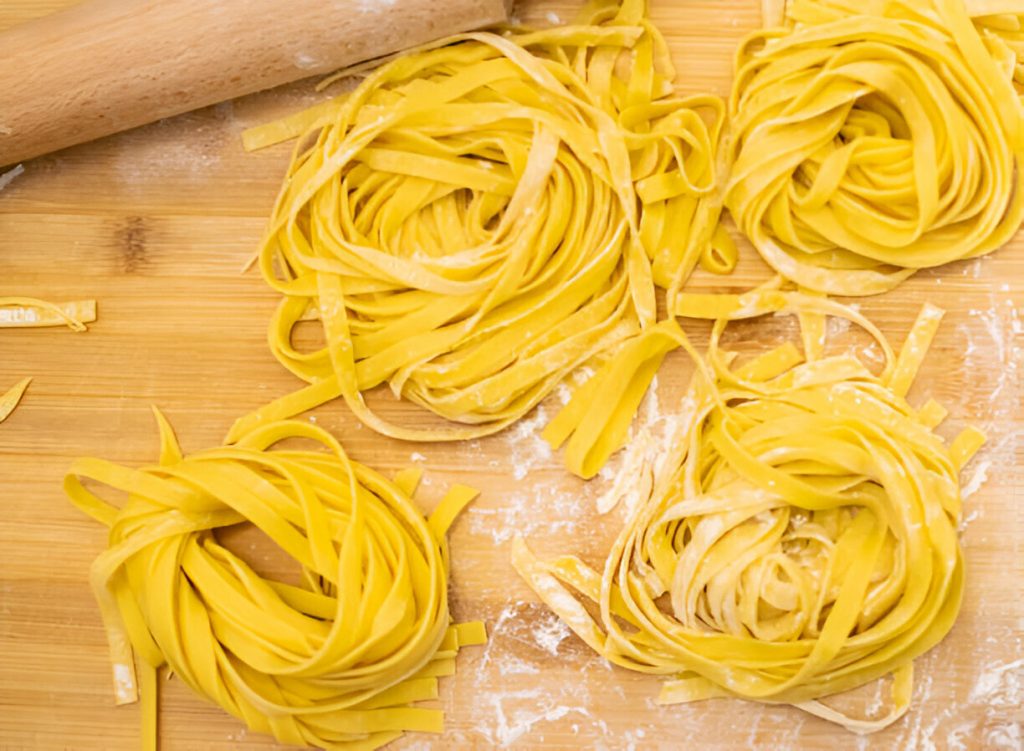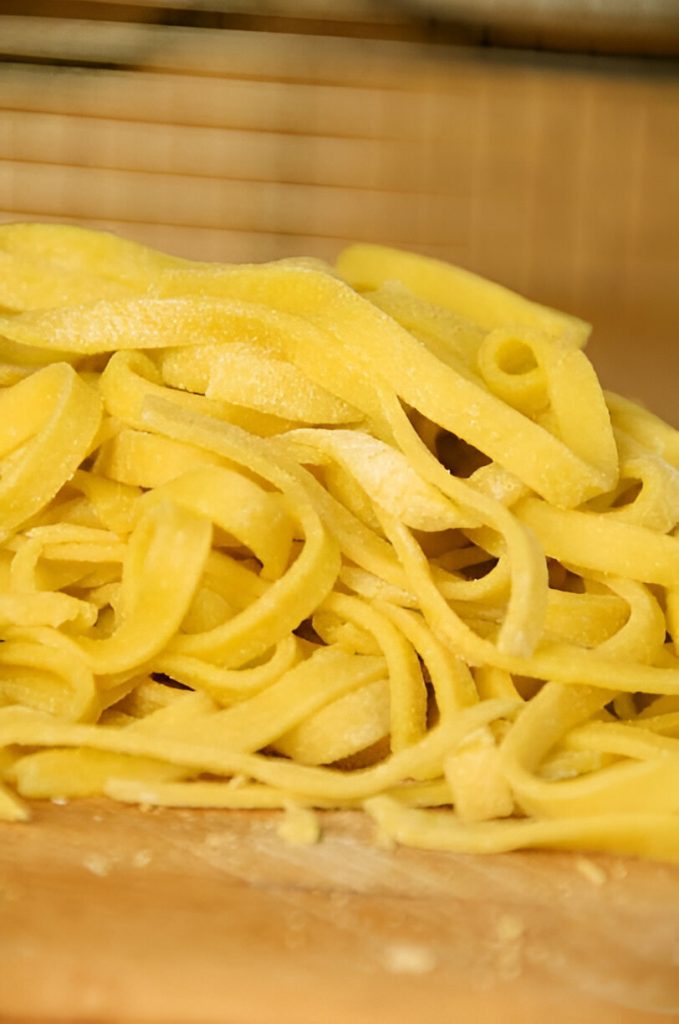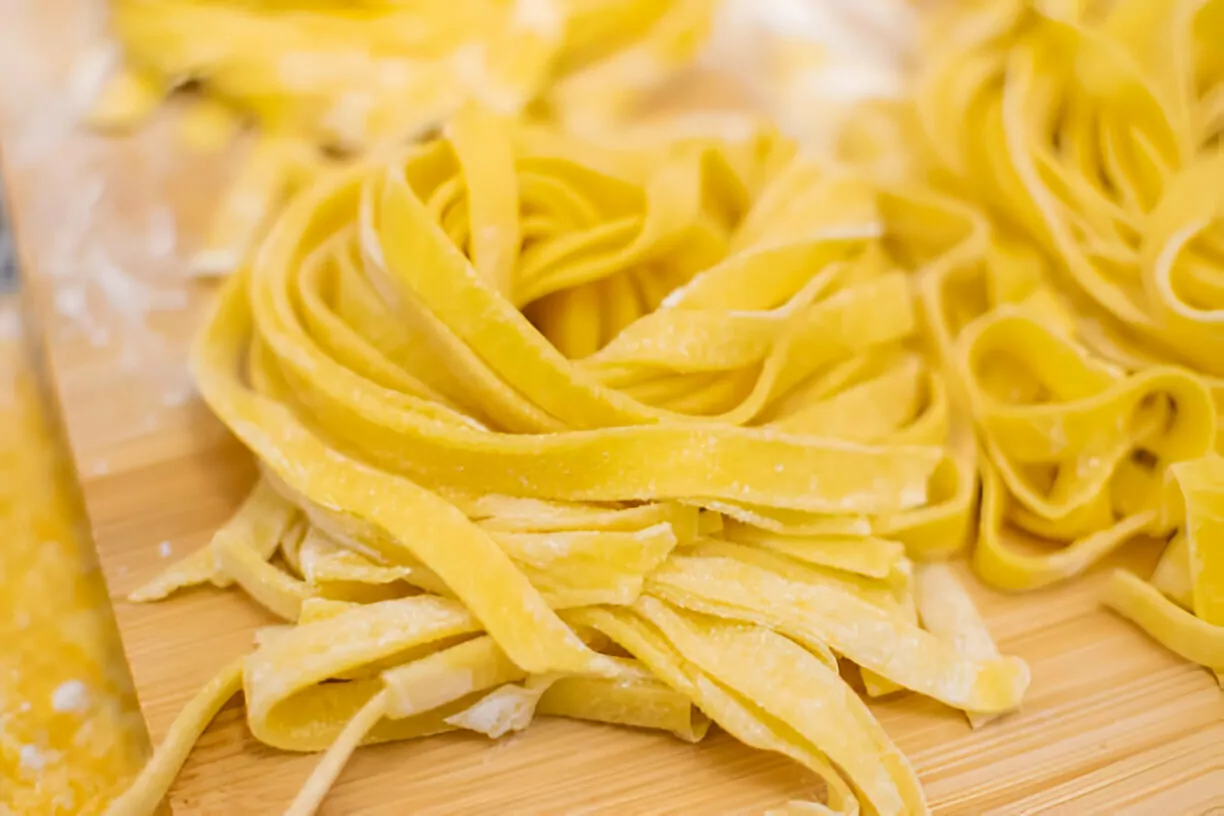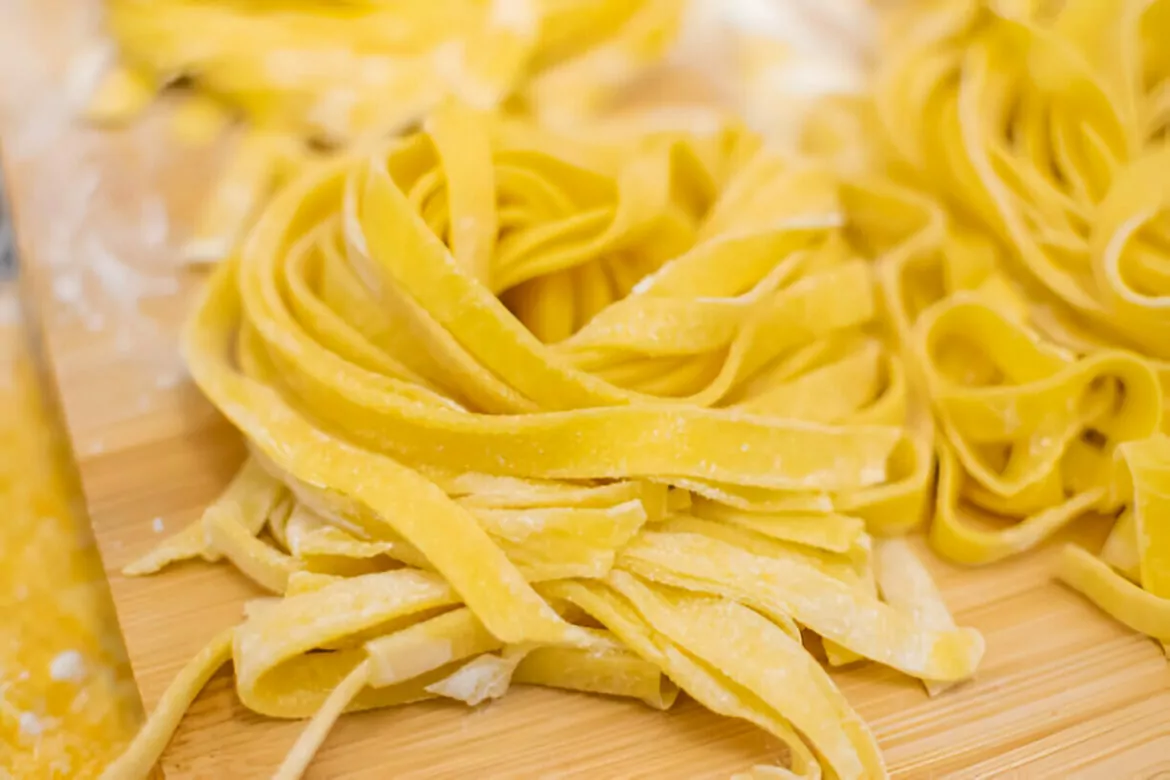Making fresh tagliatelle pasta at home is an enjoyable process that results in a delicious, authentic dish. With simple ingredients and a bit of patience, you can create silky pasta that transforms any meal into something special.

Ingredients Overview
The backbone of this recipe is all-purpose flour, which provides the perfect balance of structure and tenderness. Eggs at room temperature blend seamlessly into the dough, ensuring a smooth consistency. Olive oil and water lend elasticity, making the dough pliable and easy to work with. Together, these ingredients create a reliable base for beautifully crafted tagliatelle.
Step-by-Step Preparation Guide
Mixing and Kneading the Dough
Begin by creating a well in the flour mound, which acts as a natural bowl for the eggs, olive oil, and water. Gradually mix the ingredients with a fork, incorporating the flour slowly to prevent spills. Once the mixture becomes thick, knead it by hand. Press the dough with the heel of your palm, fold it over, and repeat until it forms a cohesive, non-sticky ball. This process, though simple, is key to achieving smooth and elastic dough.
Resting the Dough
Letting the dough rest allows the gluten to relax, making it easier to roll out later. Wrap it tightly in plastic wrap to retain moisture and avoid drying out. A 30-minute rest is sufficient to transform the dough into a pliable, workable base for your tagliatelle.
Using a Pasta Machine
Divide the rested dough into four portions, working with one at a time while keeping the others covered. Flatten the dough slightly, then pass it through the pasta machine’s widest setting. Fold and repeat this step several times to develop the dough’s structure. Gradually reduce the machine’s settings, thinning the dough sheet with each pass. Finally, attach the tagliatelle cutter and feed the sheet through to create uniform strands. Lay them on a floured surface to dry.
Rolling and Cutting by Hand
Without a pasta machine, a rolling pin works just as well. Roll a portion of dough on a floured surface into a thin rectangle. Gently roll the dough into a loose cylinder, then slice it into even strips using a sharp knife. Unroll the strands and dust them lightly with flour to prevent sticking.
Drying and Storing the Pasta
Drape the tagliatelle over a pasta drying rack or lay it flat on a floured baking sheet. Once dried, portion the pasta and store it in freezer bags. Freezing preserves its freshness for up to three months, and it can be cooked directly from frozen for convenience.
Cooking the Pasta
Bring a large pot of salted water to a boil. Add the fresh or frozen tagliatelle and cook for a few minutes until it floats to the surface, indicating it’s done. Drain and serve with your choice of sauce.

Recipe Tips
To adjust the dough consistency, add small amounts of water or flour as needed.
Achieve even thickness by rotating the dough frequently while rolling.
Store fresh pasta in a cool place to prevent it from drying out too quickly.
What to Serve With This Recipe
Pair tagliatelle with a rich Bolognese sauce for a hearty meal, or toss it in a light olive oil and herb dressing for a fresher option. Complement the dish with roasted vegetables or garlic bread on the side. For drinks, a glass of Chianti or Pinot Grigio enhances the flavors beautifully.
Frequently Asked Questions
Can I use whole wheat flour instead?
Yes, but the pasta will have a denser texture and a nuttier flavor.
Do I need a pasta machine?
No, hand-cutting works just as well, though a machine ensures consistent results.
How long does frozen tagliatelle last?
Up to three months when stored in airtight bags.
Storage and Reheating Instructions
Freeze uncooked tagliatelle in portions for easy access. To reheat cooked pasta, toss it gently in a warm sauce to prevent overcooking while maintaining its tender texture.
Experiment with sauces, toppings, and accompaniments to create a dish that’s uniquely yours. Whether for a casual dinner or a special occasion, homemade tagliatelle is a satisfying way to showcase your culinary skills.

Ingredients
3 cups (390 grams) all-purpose flour
1 teaspoon salt
4 large eggs, at room temperature
1 tablespoon olive oil
2 teaspoons water
Instructions
On a clean work surface or in a mixing bowl, form a mound with the flour, and create a well in the center. Into the well, add the eggs, salt, olive oil, and water.
With a fork, lightly whisk the eggs, gradually incorporating the flour from the inner edges of the mound. Use your other hand to gently cup the flour, maintaining the mound’s shape as you work. Once the mixture begins to come together, transition to kneading the dough with the palms of your hands. Avoid forcing all the flour into the dough; incorporate just enough until it forms a cohesive, non-sticky ball.
If the dough absorbs all the flour but remains sticky, sprinkle in additional flour a little at a time. Continue kneading for about 10 minutes—this step is essential to achieving a smooth, pliable dough. When the dough is soft and elastic, wrap it tightly in plastic wrap to prevent drying out and let it rest for 30 minutes.
For Pasta Machine Method:
After the dough has rested, divide it into four equal parts. Keep three portions wrapped while working on one. Shape the piece into a rectangle with your hands. Set your pasta machine to its widest setting and roll the dough through.
Fold the dough in half and pass it through the widest setting again. Repeat this folding and rolling process two more times. Gradually reduce the machine’s settings, rolling the dough thinner each time until you reach the desired thickness.
Attach the tagliatelle cutter to the machine and feed the dough through to form the pasta strands. Drape the freshly cut tagliatelle over your hand and transfer it to a floured surface or baking sheet to dry for about 30 minutes. Alternatively, use a pasta drying rack for this step.
To Make Without a Pasta Maker:
Take a small portion of dough and roll it out on a floured surface into a rectangle, approximately 6 inches (15 cm) by 12 inches (30 cm). Roll the dough loosely into a flat cylinder, starting from the edge closest to you.
Using a sharp knife, slice the rolled dough into strips of your desired width, such as 3/16 inch (5 mm). These slices will determine the thickness of your tagliatelle. Unroll the strands and lay them on a floured surface or drying rack.
Cooking and Storing the Pasta:
Fresh pasta is best cooked immediately. If you plan to store it, divide the pasta into portions, place each in a freezer bag, and freeze for up to three months. When needed, boil the frozen pasta directly in water without thawing, cooking for a few minutes until it floats.

Tagliatelle Pasta Recipe
Ingredients
- 3 cups 390 grams all-purpose flour
- 1 teaspoon salt
- 4 large eggs at room temperature
- 1 tablespoon olive oil
- 2 teaspoons water
Instructions
- On a clean work surface or in a mixing bowl, form a mound with the flour, and create a well in the center. Into the well, add the eggs, salt, olive oil, and water.
- With a fork, lightly whisk the eggs, gradually incorporating the flour from the inner edges of the mound. Use your other hand to gently cup the flour, maintaining the mound’s shape as you work. Once the mixture begins to come together, transition to kneading the dough with the palms of your hands. Avoid forcing all the flour into the dough; incorporate just enough until it forms a cohesive, non-sticky ball.
- If the dough absorbs all the flour but remains sticky, sprinkle in additional flour a little at a time. Continue kneading for about 10 minutes—this step is essential to achieving a smooth, pliable dough. When the dough is soft and elastic, wrap it tightly in plastic wrap to prevent drying out and let it rest for 30 minutes.
For Pasta Machine Method:
- After the dough has rested, divide it into four equal parts. Keep three portions wrapped while working on one. Shape the piece into a rectangle with your hands. Set your pasta machine to its widest setting and roll the dough through.
- Fold the dough in half and pass it through the widest setting again. Repeat this folding and rolling process two more times. Gradually reduce the machine’s settings, rolling the dough thinner each time until you reach the desired thickness.
- Attach the tagliatelle cutter to the machine and feed the dough through to form the pasta strands. Drape the freshly cut tagliatelle over your hand and transfer it to a floured surface or baking sheet to dry for about 30 minutes. Alternatively, use a pasta drying rack for this step.
To Make Without a Pasta Maker:
- Take a small portion of dough and roll it out on a floured surface into a rectangle, approximately 6 inches (15 cm) by 12 inches (30 cm). Roll the dough loosely into a flat cylinder, starting from the edge closest to you.
- Using a sharp knife, slice the rolled dough into strips of your desired width, such as 3/16 inch (5 mm). These slices will determine the thickness of your tagliatelle. Unroll the strands and lay them on a floured surface or drying rack.
Cooking and Storing the Pasta:
- Fresh pasta is best cooked immediately. If you plan to store it, divide the pasta into portions, place each in a freezer bag, and freeze for up to three months. When needed, boil the frozen pasta directly in water without thawing, cooking for a few minutes until it floats.



